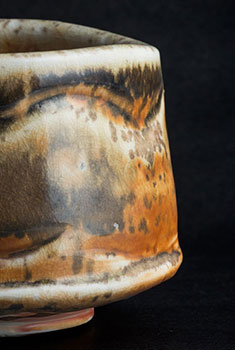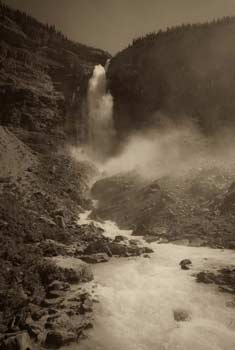- Ceramics
- Artist Pages
- Asian Ceramics & Tea
- Ceramics Artist Links
- Ceramics Links
- Ceramics Terms Glossary
- Agateware
- Banding Wheel
- Bat, Throwing Bat
- Bisqueware, Biscuit Ware
- Blistering
- Blow Up
- Boat Anchor
- Calipers
- Carbon Coring, Black Coring
- Carbon Trap
- Chuck, Chum
- Coil
- Colorants
- Crazing
- Downdraft Kiln
- EPK, Edgar Plastic Kaolin
- Electric Kiln
- Extrusion, Extruder
- Fettle, Fettling Knife
- Force Dry
- Greenware
- Kaolinite
- Kilnsitter
- Overglaze
- Pinholing
- Plucking
- Pug Mill
- Pyrometric Cones
- Raku
- Rib
- Sgraffito
- Shelf Of Shame
- Slab Roller
- Slip
- Test Tile
- Knowledge
- Frequently Ignored Answers
- Photography
- Photographers
- Photo Links
- Raw File Converters
- Camera Simulators
- Color Vision Games
- Frequently Ignored Answers
- Resources
- Contact
Emphasis, Dominance And Focal Point
Isolation - By separating the subject from other distracting elements and placing it against a plain background, the viewer is left with nothing else to focus on. In drawing and painting, etc., this means not adding anything that does not add to or emphasize the subject or purpose. Photographers need to pay special attention to what is in the background of the picture, and work to eliminate unwanted clutter. This can be done by changing the viewpoint the photo is taken from, or by masking or moving/removing things from view.
Leading Lines and Convergence - A line, arrow, or similar triangular or elongated element can indicate a direction and point towards something, leading the eye in that direction. When multiple elements converge toward a point (such as lines going back into perspective), they can create an even greater pull of attention in that direction.
Contrast - The more strongly something contrasts with its surroundings, the easier it is to see and the more energy it will seem to have. Strong contrast in value, color, etc. can make elements "pop".
Anomaly - A single square in a repeating pattern of circles will stand out - it's not like everything else, it doesn't blend in, it breaks the pattern: this can call attention and add interest. In something perfectly flat, smooth, white, etc. our eye will always be drawn to the one little flaw - the pencil scratch, the rough spot, the wrinkle. Anomaly can also be created by juxtaposing things that are not normally seen together, or depicting scenes that invert or alter the everyday.
Size - The larger it is, the more visual weight it will have and the more clearly it will be visible. Do not be afraid to fill the frame with your subject, even if it means not all of the subject will fit in the frame. Concentrate on and enlarge what is important, so the viewer can connect with it.
Placement - An element placed front and center will confront the viewer. All else being equal, a third of the way in from any border can be a visually pleasing place to locate something of importance.
Framing - Just as a picture frame sets off a painting from the wall and calls attention to the artwork, similar elements within an artwork can help direct attention. Posing or painting a figure framed by a doorway, window, objects associated with them (a cook framed by hanging pots and pans, etc.) or other environmental element can help set off the subject and tell something about it. In three-dimensional work, framing (tubes, tunnels, portals, openings, gaps, cracks, etc.) can not only reveal or limit views, they can also let in and channel light, wind and rain, creating other interest.
Focus and Depth of Field - When we look at something, we focus on it so we can see sharp detail. In art, areas depicted in sharp focus will be dominant. Depth of field is the range from near to far in which objects appear to be in focus. When you look out at a landscape, for example, everything from pretty close to far far away appears in focus (if your vision or glasses are good) and the depth of field is said to be large (deep focus). In this case, other factors than focus will direct attention within the work. If you are looking at someone's face close to yours, you may only be able to focus on their eyes, while everything else is blurry - this is called shallow depth of field, or shallow focus. Using a shallow depth of field gives the artist the ability to direct attention by choosing just what she wants to be in focus, be it near-distance, middle or far. Blurring the background can be a good way to reduce distracting elements and help isolate the subject.
Absence of Focal Points - If a work has no real focal points, then the work as a whole becomes the focal point.
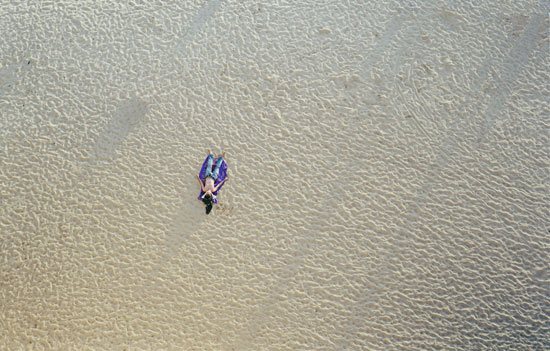
Richard Misrach - Untitled #704-03 from On The Beach, 2003. Here the photographer has isolated the subject against an interesting but uncluttered background, that complements rather than distracts. The strong contrast in colors, shapes and textures between the person on the beach and the surrounding sand clearly separate and emphasize the subject. The slightly off-center placement of the subject, along with the three framing bands of shadow cast by unseen people or things, create a natural place for the viewer's eye to start investigating the picture from.
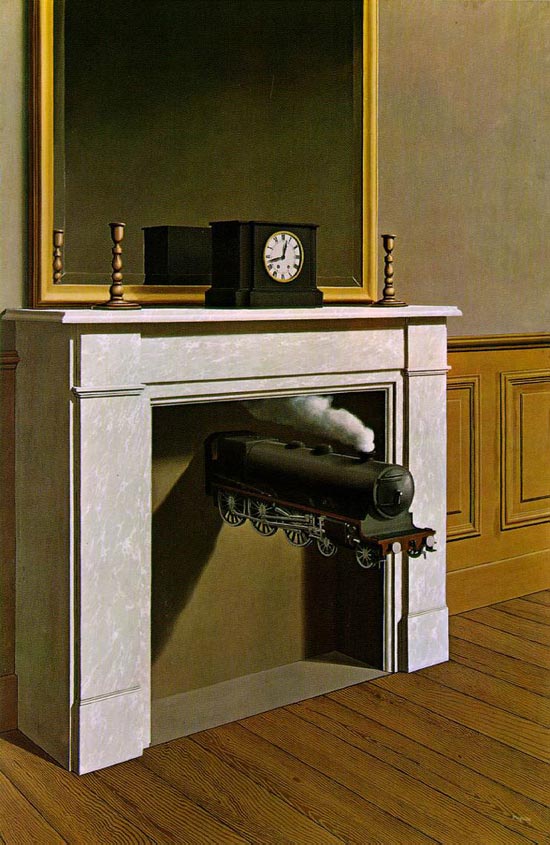
René Magritte - Time Transfixed, 1938, oil on canvas, 147 x 98.7 cm. The train is in the center of the picture, pointing straight out into the room - and it's not every day you see a train coming out of a fireplace. The fireplace also acts as a frame to further emphasize the train.
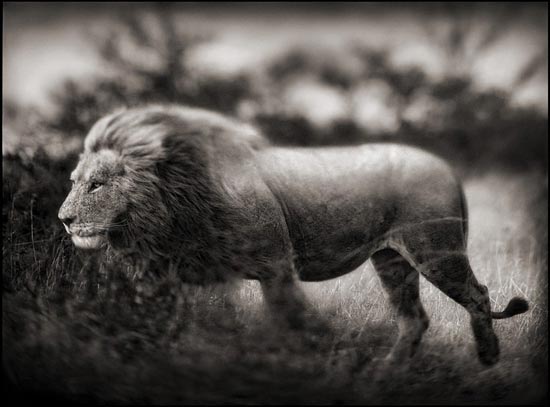
Nick Brandt - Windswept Lion, Serengeti, 2002. The shallow depth of field and focus emphasize the the lion's face, while the blurred body and background add to the windswept feeling.

Rembrandt van Rijn, The Company of Frans Banning Cocq and Willem van Ruytenburch, 1642, oil on canvas, 363 x 437 cm. Rembrandt uses a beam of light to pick the captain and his lieutenant out of the dim scene. He places the men front and just to the right of center, the light glowing off of their white ruffles, gold suit and red sash, and further leads the eye to them by having other figures and elements point in their direction. But while the primary focus of this large painting is clear, Rembrandt also makes sure the viewer becomes immersed in the whole canvas. Spears, guns, flags and arms point this way and that, leading the viewer's eye around the frame; secondary light beams pick out other faces and figures; expressions, emotions and actions fill the scene.
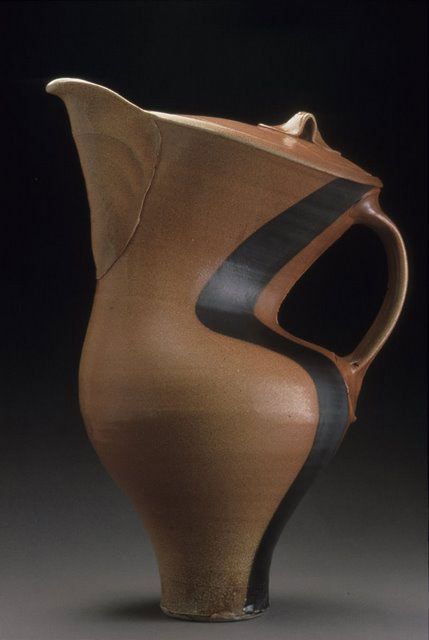
Linda McFarling. Here a simple band of black echoes and emphasizes the lively posture of the vessel.
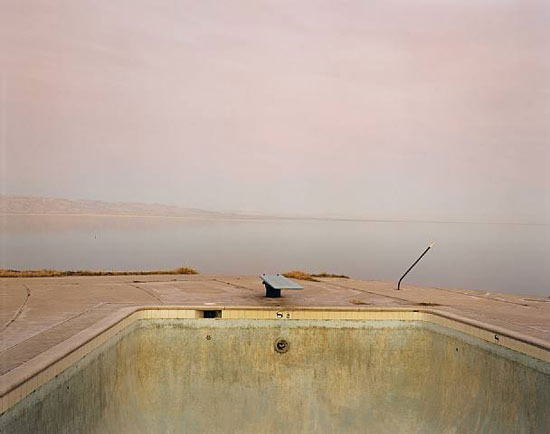
Richard Misrach, Diving Board, Salton Sea, 1983, chromogenic print, 46.4 x 58.2cm. Misrach again! Here the edges of a pool converge and lead the eye to a geometric black and gray diving board below the center of the image, standing out from the soft colors around it, and it becomes apparent that, in a barren flooded landscape, there is an empty swimming pool. The scene, quite unlike the usual view of a pool, raises questions as to how it came about, and can hold attention and be appreciated for its anomaly as well as its beauty.


